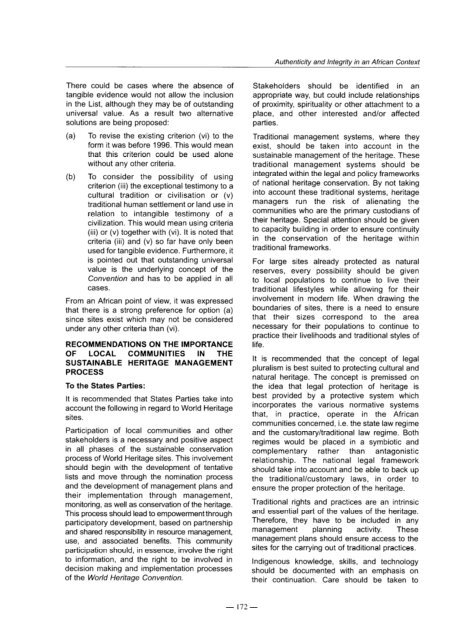Mul - unesdoc - Unesco
Mul - unesdoc - Unesco
Mul - unesdoc - Unesco
You also want an ePaper? Increase the reach of your titles
YUMPU automatically turns print PDFs into web optimized ePapers that Google loves.
There could be cases where the absence of<br />
tangible evidence would not allow the inclusion<br />
in the List, although they may be of outstanding<br />
universal value. As a result two alternative<br />
solutions are being proposed:<br />
(a) TO revise the existing criterion (vi) to the<br />
form it was before 1996. This would mean<br />
that this criterion could be used alone<br />
without any other criteria.<br />
(b) TO consider the possibility of using<br />
criterion (iii) the exceptional testimony to a<br />
cultural tradition or civilisation or (v)<br />
traditional human settlement or land use in<br />
relation to intangible testimony of a<br />
civilization. This would mean using criteria<br />
(iii) or (v) together with (vi). It is noted that<br />
criteria (iii) and (v) SO far have only been<br />
used for tangible evidence. Furthermore, it<br />
is pointed out that outstanding universal<br />
value is the underlying concept of the<br />
Convention and has to be applied in all<br />
cases.<br />
From an African point of view, it was expressed<br />
that there is a strong preference for option (a)<br />
since sites exist which may not be considered<br />
under any other criteria than (vi).<br />
RECOMMENDATIONS ON THE IMPORTANCE<br />
OF LOCAL COMMUNITIES IN THE<br />
SUSTAINABLE HERITAGE MANAGEMENT<br />
PROCESS<br />
TO the States Parties:<br />
It is recommended that States Parties take into<br />
account the following in regard to World Heritage<br />
sites.<br />
Participation of local communities and other<br />
stakeholders is a necessary and positive aspect<br />
in all phases of the sustainable conservation<br />
process of World Heritage sites. This involvement<br />
should begin with the development of tentative<br />
lists and move through the nomination process<br />
and the development of management plans and<br />
their implementation through management,<br />
monitoring, as well as conservation of the heritage.<br />
This process should lead to empowerment through<br />
participatory development, based on partnership<br />
and shared responsibility in resource management,<br />
use, and associated benefits. This community<br />
participation should, in essence, involve the right<br />
to information, and the right to be involved in<br />
decision making and implementation processes<br />
of the World Heritage Convention.<br />
- 172-<br />
Authenticity and Integrity in an African Context<br />
Stakeholders should be identified in an<br />
appropriate way, but could include relationships<br />
of proximity, spirituality or other attachment to a<br />
place, and other interested and/or affected<br />
parties.<br />
Traditional management systems, where they<br />
exist, should be taken into account in the<br />
sustainable management of the heritage. These<br />
traditional management systems should be<br />
integrated within the legal and policy frameworks<br />
of national heritage conservation. By not taking<br />
into account these traditional systems, heritage<br />
managers run the risk of alienating the<br />
communities who are the primat-y custodians of<br />
their heritage. Special attention should be given<br />
to capacity building in order to ensure continuity<br />
in the conservation of the heritage within<br />
traditional frameworks.<br />
For large sites already protected as natural<br />
reserves, every possibility should be given<br />
to local populations to continue to live their<br />
traditional lifestyles while allowing for their<br />
involvement in modern life. When drawing the<br />
boundaries of sites, there is a need to ensure<br />
that their sizes correspond to the area<br />
necessary for their populations to continue to<br />
practice their livelihoods and traditional styles of<br />
life.<br />
It is recommended that the concept of legal<br />
pluralism is best suited to protecting cultural and<br />
natural heritage. The concept is premissed on<br />
the idea that legal protection of heritage is<br />
best provided by a protective system which<br />
incorporates the various normative systems<br />
that, in practice, operate in the African<br />
communities concerned, i.e. the state law regime<br />
and the customary/traditionaI law regime. Both<br />
regimes would be placed in a symbiotic and<br />
complementary rather than antagonistic<br />
relationship. The national legal framework<br />
should take into account and be able to back up<br />
the traditional/customary laws, in order to<br />
ensure the proper protection of the heritage.<br />
Traditional rights and practices are an intrinsic<br />
and essential part of the values of the heritage.<br />
Therefore, they have to be included in any<br />
management planning activity. These<br />
management plans should ensure access to the<br />
sites for the carrying out of traditional practices.<br />
Indigenous knowledge, skills, and technology<br />
should be documented with an emphasis on<br />
their continuation. Care should be taken to

















